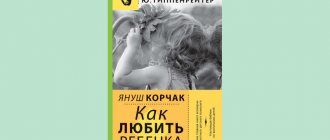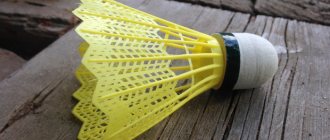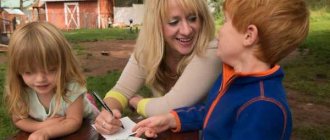Technology for constructing an educational space
The technology for constructing an educational space using a methodological constructor provides a wide field of professional freedoms for educators within a given thematic cycle.
Such freedom gives him the opportunity to independently construct a general picture of the day and even the week from individual didactic elements (effective forms, methods, means of teaching and raising children) available in the file cabinet.
Criteria for selecting didactic elements
In this case, the main criteria for choosing the appropriate didactic element are:
- personal vision, understanding and acceptance by the teacher of each educational topic;
- focusing on the capabilities, interests and inclinations of children of a particular group;
- accounting of available resources.
The advantage of planning according to the principle of a methodological designer lies, firstly, in a high degree of trust in the professional skills of the teacher, who is able to build his work with children, focusing on the feelings of the real situation, and not according to generalized standardized regulations.
Secondly, minimizing the amount of necessary documentation for daily planning significantly saves the teacher’s time and effort. That is, the teacher, from a prepared card index the day before or at the beginning of the day, selects for himself those didactic tools that he needs to work on the train of the day. This means that he does not waste precious time copying into a journal for scheduling all types of work, to which life will still make its own adjustments.
While working with children, the teacher reflects, listens with his heart and mind to himself and his students and, using the card index of the methodological designer, optimally organizes the educational process.
We note that this technology requires further development regarding practical application and, in accordance with this, at the initiative of the Ministry of Education and Science, a series of publications “Library of a Preschool Teacher” has been developed as didactic and methodological support for the Basic Component of Preschool Education.
These materials can also be used in the educational process using this technology.
Experienced teachers will discover new opportunities for creative professional self-expression in this didactic and methodological support.
And young educators will find tips on how to organize educational work during the day. the most interesting and useful for children.
Teaching preschoolers the elements of literacy
As the practice of modern preschool educational institutions shows, it is advisable to teach elements of literacy to children of senior preschool age with small groups of children, so group (up to 15 people), individual-group (4-8 people) and individual (1-4 people) will prevail. classes that bring together children of senior preschool age of approximately the same level of development (if children have different levels of development, then separate tasks should be planned for such children).
It’s no secret that among kids there are those who are already interested in sounds and letters or even read words, sentences and the like on their own. We recommend involving such children in group work.
In classes on teaching elements of literacy, which are advisable to be held once a week as a group or individually, children listen to speech, learn that it consists of sentences, sentences are built from words, and words can be divided into syllables and individual sounds.
Activities program in kindergarten “Child”
The activity program in kindergarten “Child” offers an integrative approach to organizing the educational process.
But, unfortunately, the authors of the program did not provide an approximate distribution of either subject or integrated classes for a week or a month.
This information can be extracted from some sections of the methodological recommendations for the program. For example, on speech development, it is recommended to conduct 4 classes per month: 3 comprehensive and 1 special (dominant).
Speech classes are recommended for all age groups once a week only with groups of children (up to 15 people).
If there are 20 or more children in a group, then it is advisable to divide them into 2 or more subgroups.
Distribution of complex and special speech classes during the month and quarter
| Month of the quarter | Type of speech lesson and components of program content | |||
| 1 Week | 2 week | 3 week | 4 week | |
| I | Complex: | Complex: | Complex: | Special (thematic): |
| 1. Coherent speech | 1. Coherent speech | 1. Coherent speech | Sound culture of speech | |
| 2. Grammar | 2. Dictionary | 2. Grammar | ||
| 3. Dictionary | 3. Sound culture of speech | 3. Sound culture of speech | ||
| II | Complex: | Complex: | Complex: | Special (thematic): |
| 1. Coherent speech | 1. Coherent speech | 1. Coherent speech | 1. Grammar | |
| 2. Grammar | 2. Dictionary | 2. Grammar | ||
| 3. Dictionary | 3. Sound culture of speech | 3. Sound culture of speech | ||
| III | Complex: | Complex: | Complex: | Special (thematic): |
| 1. Coherent speech | 1. Coherent speech | 1. Coherent speech | 1. Dictionary | |
| 2. Grammar | 2. Dictionary | 2. Grammar | ||
| 3. Dictionary | 3. Sound culture of speech | 3. Sound culture of speech | ||
In a preschool institution, in all age groups, integrated classes should be conducted, which combine several areas of children’s activities, and combined classes in order to consolidate the knowledge, speech and skills acquired by children.
Combined classes
Unlike an integrated lesson, a combined lesson consists of separate parts that are not interconnected and have their own program tasks from one or different divisions of the Program (language teaching and speech development with the environment, physical education, visual arts, fiction).
An important form of teaching elements of literacy to children of senior preschool age are organized classes (group, individual-group, individual).
We advise you to plan once a week group or individual group lessons to teach children the elements of literacy in the senior group, and plan and conduct individual lessons every day with individual children, taking into account their individual characteristics.
We remind you that it is advisable to teach children the elements of literacy and preparation for writing with small groups of children or as group work for children of the sixth and seventh years of life who identify the need to read and write.
Fiction classes
Classes in fiction are held in all age groups: frontal or group lessons at least once a week, individual, individual-group - almost daily.
In the system of educational work of mathematical content, it is necessary to provide for integrated, complex classes.
For example: a combination of mathematics classes with other types of activities - construction, visual arts, physical education, excursions into nature.
Physical education and music classes are planned twice a week.
In autumn, winter and spring, two physical education classes are held in the gym, and three are held outdoors.
| Forms of work | Features of organizing classes | Group | Duration, in minutes |
| Physical education classes | daily | younger | 20-25 |
| average | 25-30 | ||
| older | 30-35 | ||
| preparatory | 35-40 |
An approximate diagram of the calendar planning of the teacher’s educational work for the main routine moments of the first and second half of the day
| The first half of the day | Afternoon | |||
| Morning | Classes | Walk | Labor, independent artistic activity | Entertainment, games |
| Games, conversations, observations, work, individual work with children and parents; independent motor activity of children | Subject. Program content. Material. Plan (course) of the lesson. | Games, work, observations, sports games and exercises, individual work in various sections of the program, excursions, walks. trips outside the kindergarten, independent motor activity of children | Different types of labor (manual, household, outdoor) in different forms. independent artistic activities of children (visual, artistic and design, speech, musical, theatrical) | Various types of theaters (puppet, shadow, toys, etc.), dramatization games, performances, concerts, physical education, musical, literary leisure |
In the second half of the day, you can also schedule the activities of the clubs according to the plans of the leaders of the clubs.
Approximate diagram of calendar planning of educational work of a teacher by types of children's activities and forms of work of a teacher with children
| Play activity | Various types of games: plot-role-playing, construction-constructive, dramatization, didactic and the like. |
| Educational and cognitive activity | Classes (topic, program content, material, course of the lesson) |
| Labor activity | Various types and forms of labor |
| Communication activities | Individual, group, collective conversations with children on personal, moral and ethical topics, organization and acting out of interpersonal communication situations, etc. |
| Cognitive activity | Observations, targeted walks, excursions, children's experimentation, experiments, reading fiction, etc. |
| Motor activity | Outdoor games, elements of sports games and exercises, physical education holidays and entertainment; walks outside the kindergarten, independent motor activity of children |
| Club work | Topics of circle classes according to the plans of the circle leaders |
| Individual work with children and parents | Individual work with children in various sections of the program (games, exercises, conversations, conversations and other forms), individual conversations, conversations, consultations for parents |
Strategic goal of the subsidiary
The strategic goal of preschool education is to develop the child’s life competence, directing it towards creativity and self-realization.
The leading activity of preschool children is play. In order to provide preschool education to all children of preschool age, especially children of five years of age, the Program can also be used to work with children in short-term preschool educational institutions, general education institutions, out-of-school educational institutions, and development centers.
Children's mastery and experience of various types and forms of activities planned in block-thematic cycles ensures the systematic formation of children's ideas and knowledge, thanks to a holistic perception of the topic.
Such planning and the entire program of activities in kindergarten allows the teacher to build the educational process in such a way as to maximally realize the stated goal, the key idea through a system of classes, appropriate forms and methods of teaching, optimal for each age group.
The system of educational work on the topic is presented holistically in the proposed form of a long-term plan. Daily planning is drawn up on the principle of a methodological constructor, the elements of which during the day can be transformed, change sequence, etc., depending on the real situation.



